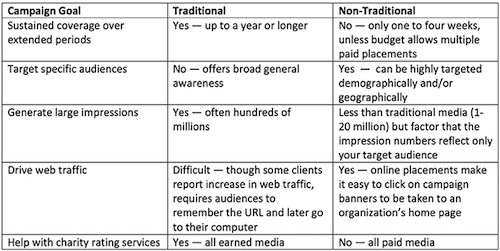|
|
Public Service Announcements have a lot more to offer today than in past years when the only option was earned placements on television and radio stations. While broadcast is still the main component, campaigns now are more integrated by incorporating new channels, channels that offer the ability to reach online audiences as well as precisely deliver messages to specific audience demographics or in certain geographies. The one-two punch of broad general awareness, coupled with precise audience targeting, is often a good combination for many campaigns. Traditional? Non-traditional? Here’s the latest and what you need to know.
Traditional media
While the FCC long ago stopped requiring broadcast stations to air PSAs, there will always be a need for them. With all the commercial slots throughout the programming day, stations simply can’t sell every single spot. Therefore, PSAs are actually needed to fill the gap. And contrary to a common misconception that spots only air in the overnight hours, a recent analysis of over 1.8 million airings generated by campaigns distributed by Connect360 Multimedia, 72 percent of airings occurred during waking day parts, and in fact, radio had a strong showing of PSA airings in the coveted morning and evening drive times, the television equivalent of prime time.
One of the best advantages to broadcast PSAs is the ability to provide sustained coverage over an extended period of time. Once a station accepts a PSA, it can stay in rotation for three months, six months, a year and even longer. That’s a lot of value from just a single distribution. Compare this coverage to most non-traditional placements, where the placement period is usually for a defined timeframe from one week to a month.
Another key benefit to a broadcast campaign is that it is earned media whereas most other platforms are paid media. The benefit to the earned media is the gift-in-kind contribution that it throws off (this is the value of the media time donated by the stations). These gift-in-kind donations are reported on a nonprofit’s financial statement. In doing so, it can help an organization’s ratio of expenses: how much they spend on their mission versus on overhead or fundraising costs. This ratio is important to donors because they want to make sure their donations are going to be spent helping the cause, rather than salaries or rent. Charity rating services such as the Better Business Bureau’s Wise Giving Alliance or Charity Navigator provide ratings based on an organization’s spending ratio, and potential donors look to these rating services to help them evaluate the best place for their dollars.
Beyond broadcast, the out of home media companies offer donated space to nonprofit organizations. Public service campaigns can be posted in malls, airports, bus shelters, train interiors and many other places.
Non-traditional media
While traditional media embraces public service campaigns to fill unsold advertising space, the social and digital media channels do not have the same need. These channels are so wildly popular with advertisers that there is little or no “free” space available, so placements generally need to be paid.
Where traditional media is about reaching masses and extended coverage, non-traditional media is all about targeting and honing in on a specific audience or geography.
PSAs placed on digital platforms such as Pandora, Spotify, Hulu, and iHeart Radio offers the ability to target a very specific audience so that your message only plays to that audience. The precise targeting is easy to accomplish because these digital platforms have captured key information based on registration forms completed by the listener. Gender, age, ethnicity and other key information is readily available. Try to reach moms of a certain age group? We can make sure your PSA plays to women in that age group that have kids. Need to reach a specific geographic? Some of these platforms can target message delivery down to zip code.
In addition, because these are paid placements, the PSA creative can push the boundaries a bit. Where broadcast campaigns are limited because they can’t have commercial ID or directly appeal for donations, these digital platforms are more open to this kind of content.
Other targeted non-traditional options include a video pre-roll (delivering your PSA to a viewer who is online and about to watch a video with subject in line with your PSA) or search intent, behavioral targeting and site retargeting campaigns reaching consumers whose online behavior indicates they would have an interest in the messaging of your PSA.
Traditional? Non-traditional? A blend?
 |
To know what’s right for you, keep in mind that the most successful campaigns come about when the goals are discussed in advance. What’s important: generating large impressions numbers, targeting specific age groups, driving website traffic, getting audiences to take a specific action or generating earned media values? Once your campaign’s objectives are identified, the best media distribution plan can easily fall into place.
If you need a visual, the chart to the right helps map campaign goals to the right media mix.
***
Annette I. Minkalis is a Partner and Executive Vice President with Connect360 Multimedia. She can be reached at [email protected].

 Annette I. Minkalis
Annette I. Minkalis

 Have a comment? Send it to
Have a comment? Send it to 
No comments have been submitted for this story yet.